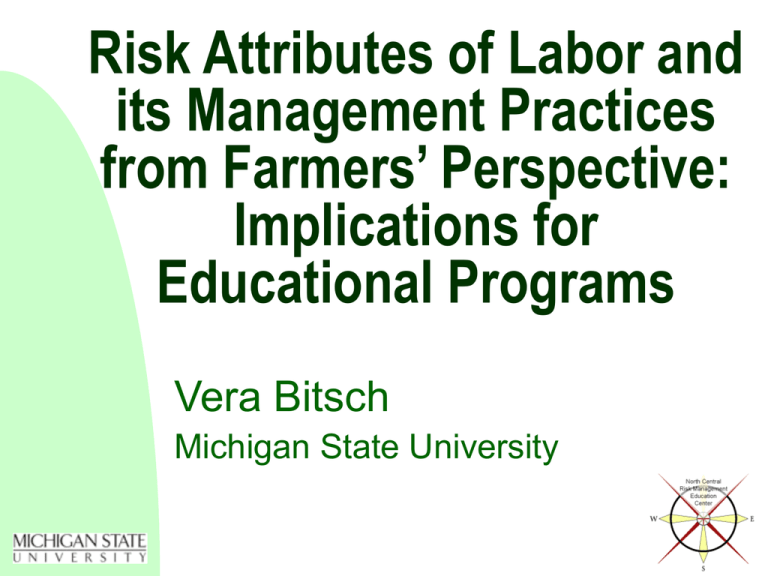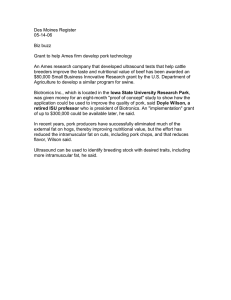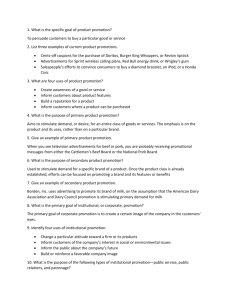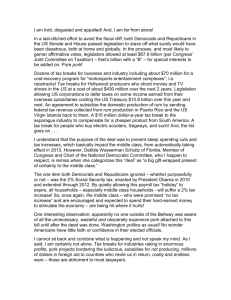Risk Attributes of Labor and its Management Practices from Farmers’ Perspective: Implications for
advertisement

Risk Attributes of Labor and its Management Practices from Farmers’ Perspective: Implications for Educational Programs Vera Bitsch Michigan State University HRM Risk Projects Horticultural operations Greenhouse, tree nursery, landscape operations Dairy farmers Pork producers Structure of Projects Contacts, partners Focus group discussions Case studies Workshops Review, publications Uses of Focus Groups Informed decision making Product, program development Customer satisfaction Input in planning and goal setting Conveying client focus Needs assessment Quality improvement effort Policy making and testing (Krueger and Casey, 2000) Focus Group Discussion Defined Data on a topic defined and structured by a researcher gathered through group interaction (Morgan, 1996) Resource efficient and flexible data collection method Projects’ Focus Groups Number of participants/meeting 8 in horticulture groups 5.5 in dairy groups 4 in pork groups Segmentation variables Location Production focus Other (pork only) Projects’ Focus Groups Cont. Number of meetings depends on number of segmentation variables theoretical saturation Number of meetings 5 in horticulture 4 in dairy 4+2 in pork Data Collection, Analysis Participant recruiting, facilitation, observation 1-page questionnaire Recording & transcripts Coding & interpretation Group summaries & aggregation Focus Group Participants Demographics Mostly male Age 22-67 yrs. In current position 15 (hort), resp. 18 yrs. (dairy, pork) Dairy: (co)owners Hort: 1:1 hired managers/owners Pork: 1:3 hired managers/owners Farm Sizes of Participants Hort industry Gross sales $100k-$70 mil. Largest: 1,600 people Dairy industry Milk sales $400k-$14 mil. Largest: 55 people Pork industry Gross revenue $980K-35 mil. Largest: 110 people Summary of Focus Group Results Differences, commonalities Small producers, contractors little interest Senior managers Middle managers Perception of training needs Top Topics based on Pork Groups Performance mgt Info #, goal setting, meetings, peer pressure Employees with baggage, lack of communication Compensation Competitive wages, benefits, perks, defined bonus Unclear system, lack of benefits, wage ceilings Important Topics Recruitment Through networks, using services, hire extra Entry level hiring, location Training Patience, hands-on, varied, safety training Send “into the fire” Working conditions Job matching, rotation Farm hours, flat orgs Other Topics Selection Criteria, tools Pressure to hire Immigrant or foreign employees Willing, able workforce Lack of communication, conflict Discipline Coaching, formal process Not using a process Other Topics Cont. Performance evaluation Clear communication, formal Not explicit, ambiguous Social environment Flex. team assignmts, meetings Disrespect by coworkers Labor laws Use specialists, knowledge Concerns, critique Structure of Pork Manager Workshop Selection Training Evaluation Compensation Conflict management Discipline and termination Communication Motivation Pork Workshop Participants & Evaluation Survey vs. in-depth KS: 19 participants MI: 27 participants Overall rating: 7.9 out of 10 Issues Location, time, duration Speakers, costs Thanks to North Central Risk Management Education Center Michigan Risk Partnership Project GREEEN at MSU S. Fogleman, S. Harsh, many other team members and consultants at MSU and beyond


